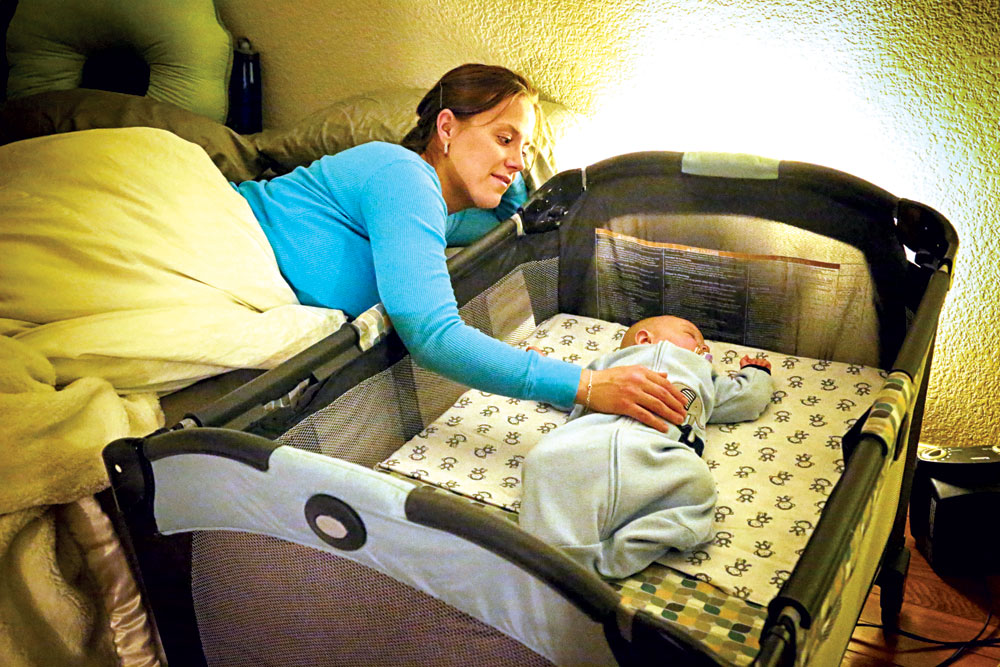
Michelle Caraballo, sleep specialist at Children’s Hospital Colorado, puts her 4-month-old, Graham, to bed in a crib that follows the recommendations for safe sleeping—a separate sleep space with no loose objects.
Walk into a typical department store that sells baby products and stroll down the bedding aisle. There will likely be an array of crib options including quilts, bumpers, sheets, stuffed animals and blankets, all embellished with tassels, bows and ruffles. While these items are cute, they are not safe or recommended by doctors.
Unsafe bedding can interfere with breathing and puts an infant at risk of accidental suffocation and Sudden Infant Death Syndrome (SIDS), or unexplained death within the first year.
Nearly 55 percent of U.S. infants sleep with potentially unsafe bedding, according to a December 2014 study by the National Institutes of Health. The rate is higher among babies of young, low- income, non-college-educated, and/or African-American or Hispanic moms.
“Parents have good intentions, but babies can sleep anywhere,” says Michelle Caraballo, MD and sleep specialist at Children’s Hospital Colorado. Unlike what most people assume, babies do not need soft cozy items in the crib to fall asleep, and it’s actually safest for it to be just the baby and the crib.
There has been a lot of research into sudden infant deaths and safe sleeping. In 1992, the American Academy of Pediatrics for the first time recommended infants sleep on their back. Two years later, the National Institute of Child Health and Human Development launched the Back to Sleep! campaign (later renamed Safe to Sleep) to teach parents the recommendations for safe sleeping.
Since 1992, the rate of SIDS has fallen by 50 percent, but has barely declined since 2000, and there has actually been an increase in accidental suffocation, according to the study.
Caraballo, a Lowry resident and first-time mom of a 4-month-old boy, thinks it’s best to introduce good sleep habits early on. But, even hospitals are guilty of unsafe practices like putting a blanket in the crib and a hat on the baby. Plus, parents receive mixed messages from products being sold at department stores, which pediatricians are fighting to get off the market. Caraballo says doctors can’t always expect parents to know all the requirements and need to educate the safe ways for babies to sleep.
Following are safety guidelines for all sleep times, including naps:
A baby should always be put to sleep on his or her back. Babies should not lie on their side or stomach, which is very high risk. A baby can roll from their side onto their stomach.
Babies should sleep on a firm surface. Sofas and recliners are especially unsafe.
Babies should sleep with no objects. “It’s not soft and cuddly, but babies are just as comfortable without,” Caraballo says. Stuffed animals, pillows, blankets, wedge positioners, etc., are all risks for suffocation.
A baby should sleep in a separate space from the parents. Adult beds are particularly high risk for suffocation with a soft mattress, pillows and blankets.
A baby should sleep in a crib, bassinette or Pack N Play within arm’s reach of a parent. Co-sleeping is a sensitive subject because it is very common and very unsafe, according to Caraballo. “Something we hear a lot is that moms perceive bed-sharing as a bonding opportunity between her and the baby.” She reassures moms that although the baby is in a separate sleeping area, the mom is close to comfort the baby. Doctors call this room sharing. A baby should be in the same room as the mom and dad until 6 months old.
A baby should not wear a hat to sleep. “The head is where babies vent excess heat,” Caraballo says. Hats are linked to overheating and should never be worn during sleep times.
A baby should wear a sleep sack and one additional layer, at most. A sleep sack is a wearable blanket that replaces loose blankets in the crib. Since 2005, the American Academy of Pediatrics has suggested using wearable blankets. A baby should not wear additional layers to avoid overheating.
A room should be kept at 68 degrees or lower.
Studies have shown that infants who use pacifiers have a lower risk for SIDS. This research is new and doctors don’t yet understand why. Carabello says it’s not necessary to reinsert the pacifier every time it pops out.
Swaddling safety tips. Swaddling is great to soothe or calm a fussy baby. A secure swaddle should snuggly wrap below the chin and align with the baby’s shoulder. But, as soon as a baby is able to roll (2–3 months), a baby should not be swaddled. At this time babies need to have their arms free.
When a baby falls asleep in a car seat, he/she should be transferred to a safe sleeping area once returning home.



0 Comments